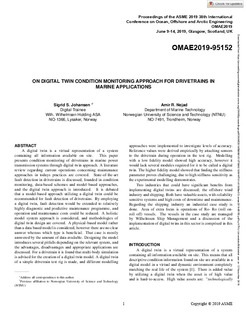| dc.description.abstract | A digital twin is a virtual representation of a system containing all information available on site. This paper presents condition monitoring of drivetrains in marine power transmission systems through digital twin approach. A literature review regarding current operations concerning maintenance approaches in todays practices are covered. State-of-the-art fault detection in drivetrains is discussed, founded in condition monitoring, data-based schemes and model-based approaches, and the digital twin approach is introduced. It is debated that a model-based approach utilizing a digital twin could be recommended for fault detection of drivetrains. By employing a digital twin, fault detection would be extended to relatively highly diagnostic and predictive maintenance programme, and operation and maintenance costs could be reduced. A holistic model system approach is considered, and methodologies of digital twin design are covered. A physical-based model rather than a data based model is considered, however there are no clear answer whereas which type is beneficial. That case is mostly answered by the amount of data available. Designing the model introduces several pitfalls depending on the relevant system, and the advantages, disadvantages and appropriate applications are discussed. For a drivetrain it is found that multi-body simulation is advised for the creation of a digital twin model. A digital twin of a simple drivetrain test rig is made, and different modelling approaches were implemented to investigate levels of accuracy. Reference values were derived empirically by attaching sensors to the drivetrain during operation in the test rig. Modelling with a low fidelity model showed high accuracy, however it would lack several modules required for it to be called a digital twin. The higher fidelity model showed that finding the stiffness parameter proves challenging, due to high stiffness sensitivity as the experimental modelling demonstrates. Two industries that could have significant benefits from implementing digital twins are discussed; the offshore wind industry and shipping. Both have valuable assets, with reliability sensitive systems and high costs of downtime and maintenance. Regarding the shipping industry an industrial case study is done. Area of extra focus is operations of Ro- Ro (roll onroll off) vessels. The vessels in the case study are managed by Wilhelmsen Ship Management and a discussion of the implementation of digital twins in this sector is comprised in this article. | nb_NO |
